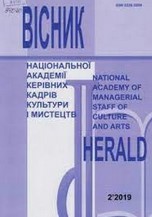КОМУНІКАТИВНІ ПРАКТИКИ В ПЕРІОД ВІЙСЬКОГО ЧАСУ: ДОСВІД ОПРАЦЮВАННЯ ПРОБЛЕМИ
WARTIME COMMUNICATIVE PRACTICES: THE EXPERIENCE OF PROCESSING THE PROBLEM
Author(s): Nataliia Anatoliyivna ZhukovaSubject(s): Theory of Communication, ICT Information and Communications Technologies, Peace and Conflict Studies
Published by: Національна академія керівних кадрів культури і мистецтв
Keywords: communication; functions of communication during military operations; communicative practices; “life world”;
Summary/Abstract: The purpose of the article is to analyze communicative practices during wartime. The methodological basis of the research is general scientific methods of analysis: historicism, systematization, comparison, and generalization of the researched problem. A phenomenological approach was used to analyze communication practices. The interdisciplinary approach allowed to involve scientific achievements in the fields of culturology, philosophy, ethics, and psychology. Scientific novelty: for the first time communicative practices in the conditions of military aggression are analyzed. Conclusions. Communicative practices as ways of interaction are aimed at transmitting information and generating meanings, creating, reproducing and transforming social reality, generating a sense of involvement in interaction with others, and hence cohesion and identification of communities and self identification of individuals. Information can be transmitted and received not only through the media, the Internet, the media, but also through art programs, works of art, accident products and more. The concept of "peaceful communicative practices" can be applied to recreational practices, empathetic, aimed at carrying positive, life affirming information useful for victory over the invader, these are communicative practices that can create various mental effects from simple distraction, entertainment - to experience levels of catharsis. The art of wartime emerges as the most direct depiction of war, documenting harsh conditions and struggle during the conflict, as well as reflection on events.
Journal: Вісник Національної академії керівних кадрів культури і мистецтв
- Issue Year: 2022
- Issue No: 2
- Page Range: 15-22
- Page Count: 8
- Language: Ukrainian

